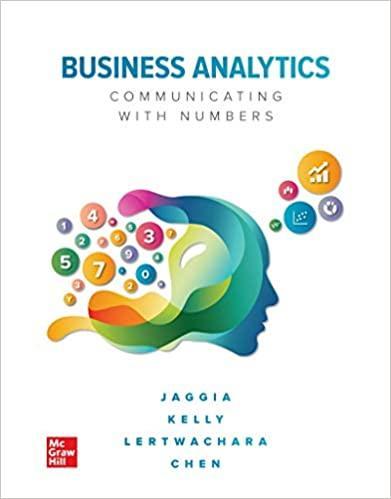Question
Create an imaginary business around your business theme. Your scenario should satisfy the following conditions: a. Include at least one one-to-one binary relationships. b. Include
Create an imaginary business around your business theme. Your scenario should satisfy the following conditions:
a. Include at least one one-to-one binary relationships.
b. Include at least one one-to-many binary relationships.
c. Include at least one many-to-many binary relationships.
d. Include at least one intersection data (on many-to-many relationships).
(Optional) You can create more relationships if needed.
Explain the story behind the scenario, and all your assumptions, which are required to support relationships given above.
2) Show entities and their attributes. Each entity should have at least three attributes, show primary keys, as well as foreign keys if exist. Draw ER diagram with correct notation (cardinality/modality). You can use any drawing software, MS Visio, diagrams.net (formerly www.draw.io), etc. In those tools you can use "Entity Diagram" section. Make sure that you ER diagram fits one pages on your project report and seems tidy and compact. If it does not fit in one page, you may upload a separate jpg file for your ER Diagram.
3) Define some referential integrity rules/constraints for your scenarios.
4) Convert the ER diagram to tables. Show your tables with primary keys, as well as foreign keys if exist.
5) Discuss database normalization rules on your tables. Do not explain what the rules are. Instead check and validate if each of tables satisfies 1NF, 2NF, and 3NF. If not, normalize your tables. Explain how you achieved normalization.
Write SQL statements to create your database and tables resulted from step 1 through 5.
7) Demonstrate data insertion into at least three tables or more. (Hint: come up with some imaginary data values for data insertion)
8) Demonstrate data deletion with at least two tables.
9) Demonstrate data update with at least one table.
10) Demonstrate a SELECT statement with WHERE statement.
11) Demonstrate a SELECT statement with GROUP BY statement.
12) Demonstrate a SELECT statement with ORDER BY statement.
13) Demonstrate a SELECT statement with HAVING statement.
14) Using two related tables (meaning logically connected with primary-key and foreign-key pairs), join these two tables to show matching rows. For instance, assume that Table A and Table B has 4 and 5 attributes respectively. Also, assume that Table A’s primary key is seen as foreign key in Table B. Join two tables to show matching rows whose primary key and foreign key is the same.
15) Demonstrate a SQL statement in which a DATE data type is subject of where statement (Hint: for example: select ... from ... where birthday > DATE.
16) Demonstrate CREATE VIEW statement.
For each step from 6) through 16), do the following:
Write your SQL Statements in MySQL Workbench or other database design tool
Run the statement.
Write simple explanation about what the SQL command does.
Step by Step Solution
There are 3 Steps involved in it
Step: 1
Creating an Imaginary Business Scenario Online Music Marketplace Scenario Explanation We will create an imaginary business scenario called Online Musi...
Get Instant Access to Expert-Tailored Solutions
See step-by-step solutions with expert insights and AI powered tools for academic success
Step: 2

Step: 3

Ace Your Homework with AI
Get the answers you need in no time with our AI-driven, step-by-step assistance
Get Started


